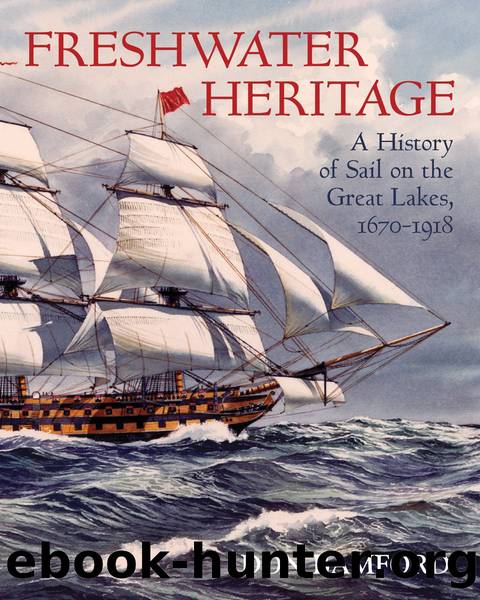Freshwater Heritage by Don Bamford

Author:Don Bamford
Language: eng
Format: epub
Publisher: Dundurn
Published: 2007-08-14T16:00:00+00:00
On large vessels, the floor pieces would be put in place, fastened and aligned. Then the half frames would be hoisted into place on both sides, and secured with shores and battens. Sketch by Heidi Hoffman.
On smaller vessels, a different technique was used. A temporary assembly platform, or framing stage, was built up across the keel. On this stage, the frame would be assembled under the supervision of the master shipwright. Since the frames were 15 to 30 feet across and up to 30 feet high, the platform must be at least this size. It would be moved along the length of the ship as the work progressed. Framing commenced near amidships where a few frames were essentially identical, but as the work progressed forward or aft, every frame became different. As the ends were approached, the curve of the shape became so extreme that it was necessary to set the frame at an angle so as to present a flat surface to the planking. This work required complex cutting where these frames joined the keel fore and aft. These were known as cant frames. Exceptional skill was required in this work.
After assembly on the platform, the frame was reinforced with cross spalls near the top, and the frame and keel were notched to accept one another. The frame was then raised into place and positioned across the keel.
Download
This site does not store any files on its server. We only index and link to content provided by other sites. Please contact the content providers to delete copyright contents if any and email us, we'll remove relevant links or contents immediately.
| Automotive | Engineering |
| Transportation |
Whiskies Galore by Ian Buxton(41885)
Introduction to Aircraft Design (Cambridge Aerospace Series) by John P. Fielding(33064)
Small Unmanned Fixed-wing Aircraft Design by Andrew J. Keane Andras Sobester James P. Scanlan & András Sóbester & James P. Scanlan(32744)
Craft Beer for the Homebrewer by Michael Agnew(18146)
Turbulence by E. J. Noyes(7942)
The Complete Stick Figure Physics Tutorials by Allen Sarah(7312)
Kaplan MCAT General Chemistry Review by Kaplan(6868)
The Thirst by Nesbo Jo(6832)
Bad Blood by John Carreyrou(6558)
Modelling of Convective Heat and Mass Transfer in Rotating Flows by Igor V. Shevchuk(6392)
Learning SQL by Alan Beaulieu(6213)
Weapons of Math Destruction by Cathy O'Neil(6152)
Man-made Catastrophes and Risk Information Concealment by Dmitry Chernov & Didier Sornette(5926)
Digital Minimalism by Cal Newport;(5669)
Life 3.0: Being Human in the Age of Artificial Intelligence by Tegmark Max(5478)
iGen by Jean M. Twenge(5368)
Secrets of Antigravity Propulsion: Tesla, UFOs, and Classified Aerospace Technology by Ph.D. Paul A. Laviolette(5311)
Design of Trajectory Optimization Approach for Space Maneuver Vehicle Skip Entry Problems by Runqi Chai & Al Savvaris & Antonios Tsourdos & Senchun Chai(5012)
Pale Blue Dot by Carl Sagan(4917)
